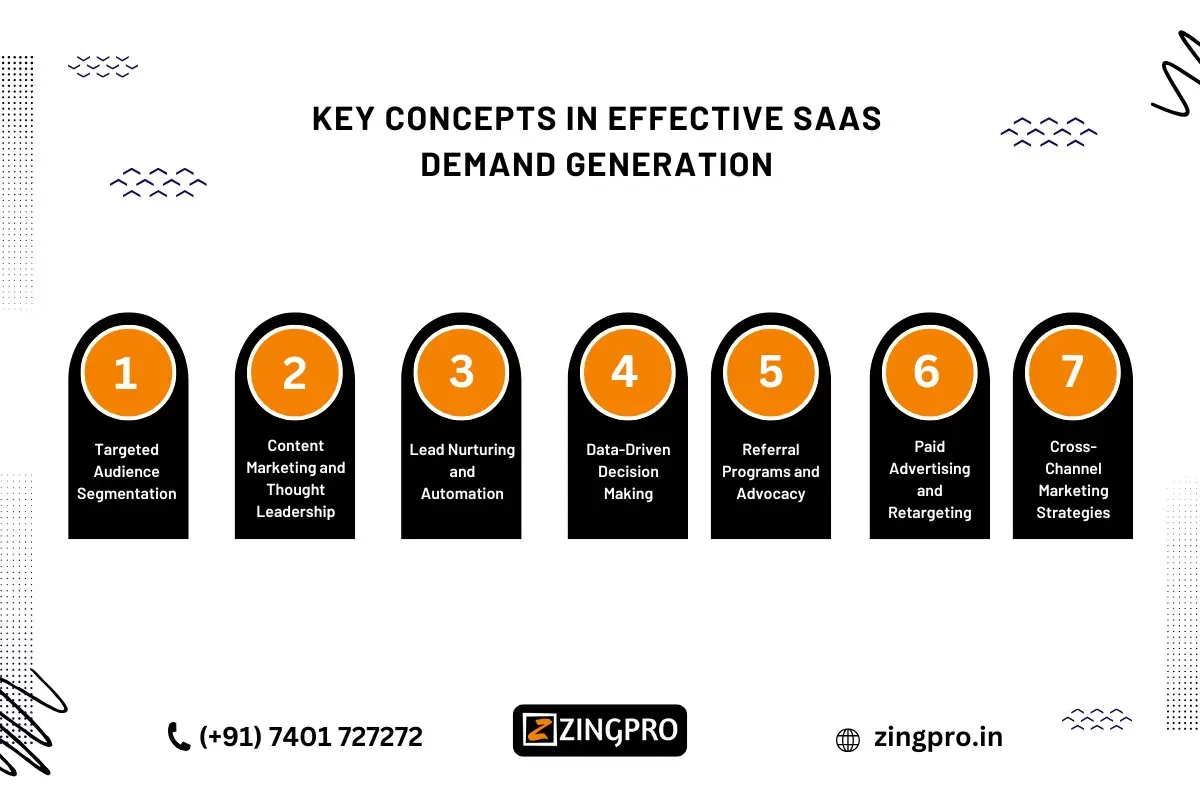In today’s competitive SaaS landscape, generating interest is key to business success. A strong SaaS strategy not only drives brand awareness but also supports long-term growth. This guide explores the importance of demand generation, covering its process, tools, and emerging trends. It emphasizes how partnering with a demand generation agency can enhance marketing efforts and ensure effective lead generation. Additionally, the guide highlights the crucial role of recruitment in building the right team to execute a successful demand generation strategy, ensuring businesses can consistently attract and convert high-quality leads in the SaaS industry.
What is SaaS Demand Generation?
SaaS demand generation refers to the process of creating and nurturing awareness, interest, and desire for software-as-a-service (SaaS) products. It involves a series of targeted marketing tactics designed to generate qualified leads, build relationships, and ultimately convert them into customers. Through a combination of content marketing, advertising, email campaigns, and social media, SaaS companies create a pipeline of potential customers who are primed for conversion.
Key components of demand generation include:
- Content Marketing: Blogs, eBooks, and videos.
- SEO and Paid Advertising: Driving traffic and visibility.
- Lead Nurturing: Automated email sequences and personalized messaging.
Partnering with a SaaS demand generation Agency helps businesses design a tailored strategy, ensuring the alignment of marketing efforts with business goals. Effective recruitment is also critical in building a capable team.

The SaaS Demand Generation Journey
The journey of SaaS demand generation starts from creating awareness about your product and nurturing potential leads into paying customers. This journey can be broken down into several key stages:
- Awareness: Potential customers become aware of your product or service. This stage typically involves content marketing, SEO, and paid advertising to bring people into your pipeline.
- Interest: Once a prospect is aware, you need to build interest through targeted offers, webinars, and lead magnets.
- Consideration: Prospects now consider your SaaS product as a solution to their problems. This phase is about providing more in-depth content and showcasing the value of your product.
- Intent: At this stage, the prospect has a strong intent to purchase. It’s essential to engage with targeted messaging, product demos, and case studies.
- Conversion: The final stage is where the lead becomes a paying customer through a seamless onboarding experience.
Each stage of the demand generation journey requires a tailored approach, and using the right tools and strategies is crucial for driving leads down the funnel. SaaS demand generation Recruitment A demand generation agency can assist in streamlining this process, optimizing campaigns, and refining targeting strategies for better outcomes.
Future Trends in SaaS Demand Generation
The future of SaaS demand generation will be shaped by these trends:
- Personalization: Customizing content and outreach to fit specific user needs will drive engagement.
- AI and Automation: Artificial intelligence will continue to play a significant role in automating repetitive tasks and personalizing campaigns.
- Account-Based Marketing (ABM): A more targeted approach focusing on high-value accounts will become more popular.
- Video Content: Video marketing will see even greater adoption for lead generation and customer engagement.
Staying ahead of these trends and adapting your SaaS demand generation strategy is critical for continued success.
Roles Driving SaaS Demand Generation
Several roles contribute to the success of a SaaS demand generation strategy. Here are some of the key positions responsible for generating demand:
- Demand Generation Manager: Develops and executes strategies to drive demand and oversee campaign performance.
- Content Marketers: Create valuable content that attracts and nurtures leads through each stage of the funnel.
- Marketing Technologists: Manage the software tools that automate and analyze demand generation activities.
- Sales Team: Converts inbound leads generated through demand generation activities into actual customers.
- Data Analysts: Analyze campaign performance and suggest improvements based on data.
By building a team with the right skill set, a SaaS demand generation Recruitment process becomes a vital aspect of building a strong pipeline for your business. This team ensures that all aspects of demand generation work seamlessly, from awareness to conversion.
Steps to Building a SaaS Demand Generation Machine
Building a successful SaaS demand generation machine involves a series of deliberate steps. Here’s how to create a well-oiled system:
- Define Your Target Audience: Clearly identify your ideal customers and tailor your marketing efforts to address their pain points.
- Create High-Value Content: Develop blog posts, ebooks, webinars, and case studies that engage potential customers at various stages of the journey.
- Implement Marketing Automation: Use tools like HubSpot, Marketo, or Pardot to streamline processes, nurture leads, and score prospects.
- Leverage Paid Ads: Use Google Ads, LinkedIn Ads, or Facebook Ads to drive targeted traffic to your landing pages and offers.
- Align Sales and Marketing: Ensure both teams collaborate closely to convert leads effectively. Use CRM systems to track leads from top to bottom of the funnel.
- Measure and Optimize: Continuously monitor your campaigns and optimize based on data to improve conversion rates and cost-efficiency.
By following these steps, your SaaS demand generation strategy can be streamlined, helping you create a repeatable and scalable process that drives high-quality leads and conversions.
10 Benefits of Hiring a SaaS Demand Generation
Working with a SaaS demand generation agency provides several key benefits:
- Expertise: Agencies bring specialized knowledge in SaaS marketing and demand generation tactics.
- Time Savings: Outsourcing demand generation allows you to focus on core business activities.
- Cost Efficiency: Agencies have the right tools and strategies to SaaS demand generation Recruitment optimize your budget and increase ROI.
- Scalability: They can help scale campaigns as your business grows, ensuring lead flow remains consistent.
- Advanced Analytics: Agencies can provide insights and data-driven decisions to improve your strategy.
- Targeted Campaigns: A focus on segmentation allows for more effective lead nurturing and higher-quality prospects.
- Automation: Agencies have the experience to integrate marketing automation tools, saving you time and increasing efficiency.
- Content Creation: High-quality, targeted content creation that aligns with your audience’s needs.
- Faster Results: Agencies help fast-track your demand generation efforts by implementing proven strategies.
- Innovation: They keep up with the latest trends in SaaS demand generation, ensuring you stay ahead of the curve.
Measuring the Performance of SaaS Demand Generation
Measuring the success of your SaaS demand generation strategy is crucial for understanding what’s working and what needs improvement. Key metrics to track include:
- Lead Generation: The number of new leads generated from campaigns.
- Conversion Rates: How many of the leads convert into paying customers.
- Customer Acquisition Cost (CAC): The cost to acquire a new customer, SaaS demand generation Recruitment including all marketing and sales expenses.
- Revenue Growth: The revenue generated from the leads nurtured through your campaigns.
- Engagement Rates: How engaged your audience is with your content, including open rates, click-through rates (CTR), and social media engagement.
Using these metrics, businesses can adjust their SaaS demand generation strategy to improve lead quality, reduce costs, and increase revenue.
Essential Tools for SaaS Demand Generation
To execute a successful SaaS demand generation strategy, having the right tools in place is essential. Some top tools include:
- HubSpot: A powerful inbound marketing platform for lead nurturing and automation.
- Marketo: A comprehensive marketing automation tool with robust lead management capabilities.
- Salesforce: CRM software that helps track and convert leads generated through demand generation efforts.
- LinkedIn Ads: A platform for running highly targeted ads aimed at professionals and businesses.
- Google Analytics: A must-have tool for tracking website traffic, user behavior, and campaign performance.
Using these tools together creates a seamless and efficient demand generation machine.
Overcoming Common Challenges in SaaS Demand Generation
SaaS demand generation is not without its challenges. Here are common issues and ways to overcome them:
- Lead Quality: Not all leads are created equal. Focus on quality over quantity and implement lead scoring systems.
- Conversion Optimization: Often, leads don’t convert at the expected rate. A/B testing and optimizing your landing pages can help.
- Nurturing Leads: Not all prospects are ready to buy immediately. Implement targeted email drip campaigns to keep leads engaged.
A SaaS demand generation agency can help overcome these challenges by implementing best practices, testing strategies, and ensuring continuous optimization.
Conclusion
Effective demand generation is essential for scaling your SaaS business. From understanding the journey to implementing the right tools and measuring performance, there are numerous steps to take to succeed. Whether through a demand generation agency, optimizing recruitment, or refining your strategy, these elements combine to create a powerful pipeline for sustained growth.
Read also Outsourced Sales and marketing.

